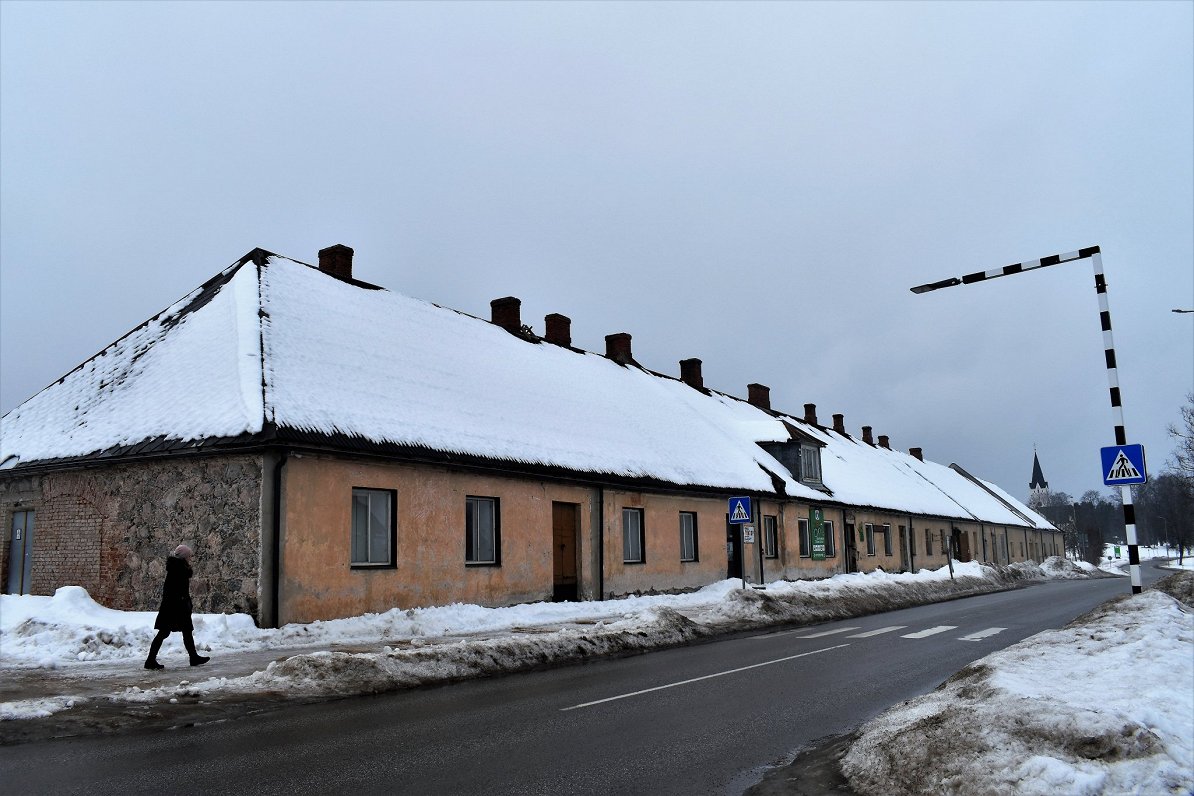Fortunately, there are a few brave souls ready to take on the headaches and wallet aches such projects entail. For example, in Jaunpiebalga, 150 kilometres east of Rīga, husband and wife team Ainārs and Aija Sils have spearheaded numerous projects to save neglected reminders of the town’s rich history.
The couple first bought a farm in the hilly Piebalga region of Vidzeme in the early 1990s as a summer cottage. But when their children grew up, they moved there full time. But in spite of the lovely surroundings, they are very busy folk.
Ainārs earns a living crafting metal objects like badges for the military and ceremonial chains for judges. In 2015, he was looking for a new space for his studio, and when the town’s old krogs (Latvian for inn or pub), came up for sale, he bought the property, encompassing the main structure, a stone ancillary building and a wooden shed.
There’s certainly no shortage of space here. At 110 metres long and 13 metres wide, the Jaunpiebalga krogs is the largest of its kind in Latvia. And as these taverns were usually located on main roads, many were destroyed during the world wars, making it a unique monument.
Built in 1800, the building’s size reflected its strategic position on the highway linking Warsaw and St. Petersburg. Inns were placed approximately every ten kilometres, and by law they had to keep fresh horses for government couriers.
Business was so brisk that in its heyday the krogs employed 15 people. Although the German barons who owned these establishments made a pretty penny by holding a state monopoly on vodka sales, the krogs also contributed to the development of Latvian culture.
“The krogs wasn’t just for eating, drinking and sleeping,” says Ainārs. “Our first choirs and theatres gathered in them, making them the cultural and recreational centers of their time.”
After hosting shops and apartments in the Soviet era, by the time Ainārs arrived the place was very run down. He points out where the old arches leading to stables at both ends of the building were clumsily altered and bricked in, leading to cracking in the façade.
Still, a new roof was put on thanks to funding from the National Cultural Monuments Board. And renovations continue, utilising bricks sourced from other old houses being demolished and refurbishing original timber on site.
Eventually, Ainārs plans to open a small guesthouse and create spaces for local artists and artisans. He had hoped to have a café up and running in the ancillary building by this spring, but the old chimney needs to be reinforced with steel rods, causing delays.
But he takes such challenges in his stride. This is not about earning a hefty profit.
“I love old buildings and restoring them,” he says. “But it’s more like a hobby because of all the expenses and problems. If you can break even, you’re doing well, but I enjoy it very much.”
Due to its hilly terrain, the Piebalga region is not a center of agriculture. Instead, its residents have historically been skilled craftspeople, and thanks to the work of the Moravian Brethren in Vidzeme, by the 19th century it had a high rate of literacy. Native sons like composer Emīls Dārziņš and brothers Reinis and Matīss Kaudzītis, who penned the first Latvian novel “The Time of the Land Surveyors,” made Piebalga a cradle of the first National Awakening.
Aija Sils draws on these traditions in her role as the principal of Jaunpiebalga’s Music and Art School. And the handsome stone building it occupies is another fine example of restoration.
Built in 1857 as a clinic for the local manor, it continued receiving patients into the 21st century. A decade ago, Aija led a drive to transform the building into a hub of learning. Today, youngsters practice musical instruments, weave on looms and learn metalwork and other skills in the school.
Aija admits to having some differences of opinion with Ainārs regarding restoration. He would have preferred to have an old timber patio restored to its original form, whereas it is now a cosy alcove inside. Aija replies that occasionally the need to get the job done on time and satisfy funding requirements takes precedence over architectural purity.
And she is proud of how the school helps to families in the district amidst widespread rural population decline.
“We’ve created a haven where kids can safely and productively spend their time after school, and this is greatly appreciated by their parents,” she says. “I’d certainly like to have a place like this for my own children.”
The couple have also been strongly behind the restoration of Jaunpiebalga’s Lutheran church. Built in 1804, it has 800 seats, making it the largest rural church in Latvia. Like the krogs, its scale indicates how prosperous Piebalga was two centuries ago.
The church escaped the wholescale destruction suffered by many other places of worship when the communist regime took over, thanks to the local parish priest quickly boarding up the windows and making it look abandoned. Today, the grand windows, an unusual flat ceiling decorated with stars and an organ dating from 1904 have all had a facelift.
Aija plays this venerable instrument at Sunday services. But she doesn’t mind when some of her old music school pupils pop in to play the hymns.
“It’s nice to occasionally have at least one day of the week off,” she says.
For Ainārs, the church is another step in rejuvenating a land he clearly loves.
“Because of the wars and the Soviet period, we don’t have many heritage buildings left in Latvia,” he laments. “But if we all do our bit, the results can be fantastic.”






























